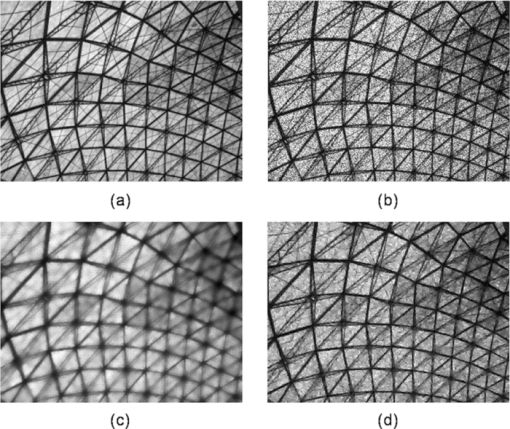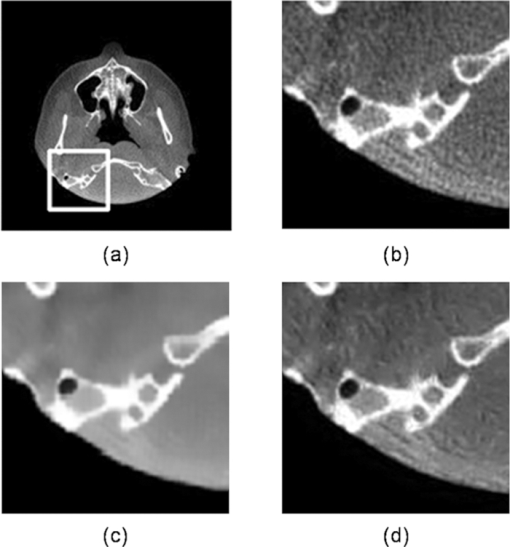|
|
1.IntroductionImage noises are difficult to model due to the limitation of the imaging system which makes the image restoration not an easy task. In many scientific applications, a robust filter is desirable and crucial for the image pre-processing. Moreover, in some special applications, for example in medical diagnosis, the visibility of structure details is also very important, so the destination of denoising is not only to pursue a higher signal-to-noise ratio, but also to produce a satisfying visual quality. A number of denoising algorithms have been presented, such as statistical and diffusion-based filters,1, 2 that restore the image through calculating local statistics or gradient information. The nonlocal means (NL-means)3 indicates that each pixel is restored as an average weighted by the intensity similarity of neighboring pixels. The block-wise NL-means approach4 based on a Bayesian framework is very efficient in reducing speckle noises while preserving edges. The mean shift (MS) method5 weighting the neighboring pixels uses a kernel comprised of a spatial component and an intensity component. The spatial component makes it more robust than replacing a pixel's value with a simple weighted average of intensity. In this paper, we propose a nonlocal oriented method which is more robust than the classical MS and NL-means in smoothing homogeneous areas while preserving tiny textures. 2.Related WorksThe weights of MS filters are formatted with two components:5 Eq. 1[TeX:] \documentclass[12pt]{minimal}\begin{document}\begin{equation} K_{h_s,h_r } (x) = Ck\left( \left\| {\frac{{x^s }}{{h_s }}} \right\|^2 \right)k\left(\left\| {\frac{{x^r }}{{h_r }}} \right\|^2 \right).\end{equation}\end{document}The NL-means3 estimates the pixel iwith a weighted average of all the pixels, Eq. 2[TeX:] \documentclass[12pt]{minimal}\begin{document}\begin{equation} NL[v](i) = \sum_{j \in I} {w(i,j)v(j)}, \end{equation}\end{document}Eq. 3[TeX:] \documentclass[12pt]{minimal}\begin{document}\begin{equation} w(i,j) = Ce^{ - \frac{{\| {N_i - N_j }\|_{2,a} ^2 }}{{h^2 }}}. \end{equation}\end{document}3.Nonlocal Oriented Weights EstimatorBased on NL-means, we propose the nonlocal oriented mean shift filter (NL-OMS). The weights estimator is the improved MS kernel and computed as a weighted value of all the image blocks. This method can be considered as a block-wise NL-means with variable bandwidths adapted to local features. The current block is recovered as, Eq. 4[TeX:] \documentclass[12pt]{minimal}\begin{document}\begin{equation} {\rm NL\!-\! OMS}(u)(B_i) = \sum_{j \in I} {K(B_j,B_i)u(B_i)},\end{equation}\end{document}Eq. 5[TeX:] \documentclass[12pt]{minimal}\begin{document}\begin{equation} K(B_j,B_i) = Ce^{ - |j - i|^2/h_1 ^2} e^{ - || {u(B_j) - u(B_i)}||_2^2 / h_2 ^2}, \end{equation}\end{document}Eq. 6[TeX:] \documentclass[12pt]{minimal}\begin{document}\begin{equation} {\rm NL\hbox{-}OMS}(u)(x_i) = \overrightarrow G (B_i)*{\rm NL\hbox{-}OMS}(u)(B_i), \end{equation}\end{document}Eq. 7[TeX:] \documentclass[12pt]{minimal}\begin{document}\begin{equation} \| {u(B_j) - u(B_i)} \|_2^2 \equiv \sum\limits_{p \in B_j \cap B_i } {[u^{(p)} (B_j) - u^{(p)} (B_i)]} ^2\vadjust{\pagebreak} \end{equation}\end{document}4.Experiments and ValidationWe assume a speckle noise model4 to perform the simulation. In the experiment on textured data (Fig. 1), the “roof” image is used as the ground truth to test the performance of preserving textures with different methods. The noisy image is obtained by adding speckle noise under three different noise-level hypotheses with σ ∈ {15, 30, 50} and other parameters are selected as recommend in Refs. 4 and 5. The bottom row demonstrates the results processed with NL-means and NL-OMS respectively. Figure 1 is more similar to the ground truth visually than Fig. 1 and the edges are significantly protected. Table 1 lists the comparison in terms of PSNR (peak signal-to-noise ratio) index including MS and nondenoising. The numeral results objectively show the performance of the proposed method in denoising. Figure 2 is a real cone-beam computer tomography (CBCT) image. There are distinct speckle noises in the homogeneous region and the structures are polluted by granules. The noise level is reduced with NL-means, but the important anatomical details are also blurred, as shown in Fig. 2. Using NL-OMS, it can be clearly seen that the whole image quality is improved, and the anatomical details are preserved in Fig. 2. Not considering the computational burden, it is worthy to gain quality improvement to avoid inaccuracy in diagnosis. Moreover, we will focus on promoting the efficiency of the proposed algorithm in a future work. Fig. 1Roof images in experiment. (a) Original image. (b) Noisy image (σ = 15). (c) Result with NL-means. (d) Result with NL-OMS.  Fig. 2CBCT images in experiment. (a) CBCT image. (b) Zoomed view of highlighted region. (c) Result with NL-means. (d) Result with NL-OMS.  Table 1Comparison of PSNR with different methods.
5.ConclusionsCombining with the nonlocal means and mean-shift methods, we derive a nonlocal weights estimator for image noise reduction. The novel estimator considers not only the similarity of intensity, but also the spatial relationship between image blocks. Denoising is performed with an oriented filter adapted to the variations of local intensity. This novel method is more robust than the classical nonlocal means filter and mean-shift filter in smoothing homogeneous areas while preserving edges. ReferencesD. T. Kuan, A. A. Sawchuk, T. C. Strand, and P. Chavel,
“Adaptive noise smoothing filter for images with signal dependent noise,”
IEEE Trans. Pattern Anal. Mach. Intell., 7
(2), 165
–177
(1985). https://doi.org/10.1109/TPAMI.1985.4767641 Google Scholar
K. Krissian, C. Westin, R. Kikinis, and K. Vosburgh,
“Oriented speckle reducing anisotropic diffusion,”
IEEE Trans. Image Processing, 16 1412
–1424
(2007). https://doi.org/10.1109/TIP.2007.891803 Google Scholar
A. Buades, B. Coll, and J. Morel,
“A nonlocal algorithm for image denoising,”
60
–65
(2005). https://doi.org/10.1109/CVPR.2005.38 Google Scholar
P. Coupe, P. Hellier, C. Kervrann, and C. Barillot,
“Nonlocal means-based speckle filtering for ultrasound images,”
IEEE Trans. Image Processing, 18
(10), 2221
–2229
(2009). https://doi.org/10.1109/TIP.2009.2024064 Google Scholar
D. Comaniciu and P. Meer,
“Mean-shift: A robust approach toward feature space analysis,”
IEEE Trans. Pattern Anal. Mach. Intell., 24
(5), 603
–619
(2002). https://doi.org/10.1109/34.1000236 Google Scholar
S. P. Awate and R. T. Whitaker,
“Unsupervised, information-theoretic, adaptive image filtering for image restoration,”
IEEE Trans. Pattern Anal. Mach. Intell, 28
(3), 364
–376
(2006). https://doi.org/10.1109/TPAMI.2006.64 Google Scholar
|
|||||||||||||||||||||||||

